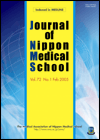81 巻, 1 号
選択された号の論文の12件中1~12を表示しています
- |<
- <
- 1
- >
- >|
Photogravure
-
2014 年 81 巻 1 号 p. 2-3
発行日: 2014年
公開日: 2014/03/10
PDF形式でダウンロード (377K)
Originals
-
2014 年 81 巻 1 号 p. 4-11
発行日: 2014年
公開日: 2014/03/10
PDF形式でダウンロード (735K) -
2014 年 81 巻 1 号 p. 12-18
発行日: 2014年
公開日: 2014/03/10
PDF形式でダウンロード (174K) -
2014 年 81 巻 1 号 p. 19-27
発行日: 2014年
公開日: 2014/03/10
PDF形式でダウンロード (333K) -
2014 年 81 巻 1 号 p. 28-34
発行日: 2014年
公開日: 2014/03/10
PDF形式でダウンロード (139K)
Case Reports
-
2014 年 81 巻 1 号 p. 35-39
発行日: 2014年
公開日: 2014/03/10
PDF形式でダウンロード (501K) -
2014 年 81 巻 1 号 p. 40-42
発行日: 2014年
公開日: 2014/03/10
PDF形式でダウンロード (217K) -
2014 年 81 巻 1 号 p. 43-47
発行日: 2014年
公開日: 2014/03/10
PDF形式でダウンロード (240K) -
2014 年 81 巻 1 号 p. 48-52
発行日: 2014年
公開日: 2014/03/10
PDF形式でダウンロード (987K)
Short Communication
-
2014 年 81 巻 1 号 p. 53-56
発行日: 2014年
公開日: 2014/03/10
PDF形式でダウンロード (71K)
Abstracts of the 2013th Encouragement Award's Memorial Lectures of the 81st Annual Meeting of the Medical Association of Nippon Medical School
-
2014 年 81 巻 1 号 p. 57-58
発行日: 2014年
公開日: 2014/03/10
PDF形式でダウンロード (31K) -
2014 年 81 巻 1 号 p. 59-60
発行日: 2014年
公開日: 2014/03/10
PDF形式でダウンロード (29K)
- |<
- <
- 1
- >
- >|
